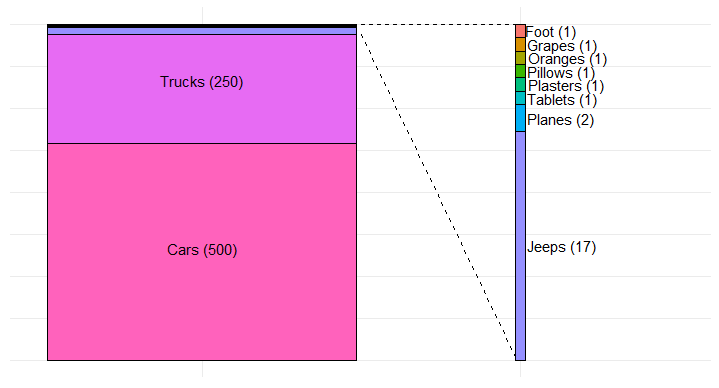After playing with this for a bit I think 'just use a table' might be the best approach, but I tried a few of R's methods for showing this kind of information so I'm including as an answer in case it's useful.
Here's the data in R (data.table package)
library(data.table)
dat <- fread(text="Cars 500
Trucks 250
Jeeps 17
Planes 2
Foot 1
Oranges 1
Plasters 1
Grapes 1
Tablets 1
Pillows 1", header=FALSE) |> setNames(c("Category", "Frequency"))
Edit: you can add labels directly onto a waffle plot by extracting the locations of the plotted tiles. So:
# create a waffle plot
library(waffle)
library(data.table)
w1 <- ggplot(dat[sample(nrow(dat)),], aes(fill=Category, values=Frequency)) +
geom_waffle(n_rows=50, col=NA) +
theme_void() +
scale_fill_brewer(palette="Paired") +
theme(legend.position = "none")
# extract the locations of the plotted tiles
d1 <- ggplot_build(w1)$data |> as.data.table()
# take the average position for each group
# (relies on each group having a different fill colour)
regiondata <- d1[, .(x=mean(x), y=mean(y)), by=fill]
# now draw the plot, and add the labels
w1 + geom_text(aes(
label = Category,
x = regiondata$x,
y = regiondata$y,
size = Frequency
)) +
scale_size_binned()

You can play with the size scale or maybe with ggrepel to get better sizing and placement of the labels.
Be careful that the labels are plotted in the right order, this relies on the order in the ggplot data being the same as the order the waffle plot is built in. So far this seems to be the case but it's worth checking.
First I tried the waffle and treemapify (as you did) R packages:
library(waffle)
ggplot(dat, aes(fill=Category, values=Frequency)) +
geom_waffle(n_rows=50, col=NA) + theme_void()

ggplot(dat, aes(area = Frequency, fill = Category, label = Category)) +
geom_treemap(layout="srow") +
geom_treemap_text(layout="srow")+
scale_fill_brewer(palette="Paired")

Neither of these works great when the distributions are so skewed, but they do convey the sense of area pretty well. If you can figure out how to label the waffle plot without using a legend it might work well.
I looked at facet_zoom from ggforce but I don't think it works in this case. So I tried to re-implement it as a pair of stacked bar charts with varying widths. Again not sure if it works particularly to convey your message, but it's possible you could adapt it.
This works by duplicating the dataset, with one part only having the low frequencies, then plotting two stacked bars side by side with some annotation to indicate the zooming and variable widths to make the relative areas correct:
dat[, prop:=Frequency/sum(Frequency)]
datlong=rbindlist(list(full=dat,zoomed=dat[Frequency<100]), idcol="part")
datlong[, sum:=sum(Frequency), by=part]
datlong[, grandsum:=sum(Frequency)]
ggplot(datlong) + aes(x=part, y=Frequency, fill=reorder(Category, Frequency)) +
geom_col(position="fill",width=width,col="black",aes(width=sum/grandsum)) +
geom_text(aes(label=sprintf("%s (%d)",Category,Frequency)),
position = position_fill(vjust=0.5),
data=datlong[(part=="full" & Frequency>100)]) +
geom_text(aes(label=sprintf("%s (%d)",Category,Frequency)),
position = position_fill(vjust=0.5),hjust=-0.1,
data=datlong[(part=="zoomed")]) +
theme_minimal()+
theme(legend.position = "none",
axis.text = element_blank()) +
annotate(x=1.5,xend=1.99,
y=1-sum(datlong[part=="zoomed", prop]),
yend=0, geom="segment", lty="dashed")+
annotate(x=1.5,xend=2.0,
y=1,yend=1, geom="segment", lty="dashed")+
labs(x=NULL, y=NULL)

But I don't honestly think it's better than a table or a description in text would be.






